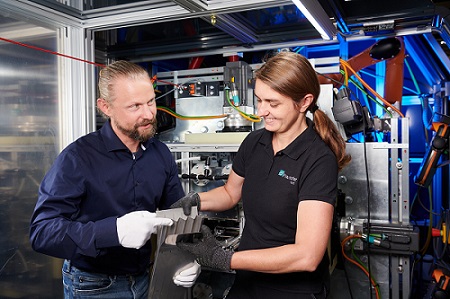DRESDEN, Germany, April 14, 2023 — Researchers at the Fraunhofer Institute for Material and Beam Technology IWS (Fraunhofer IWS) have developed an approach to apply modern lightweight construction design principles beyond the automotive and aerospace industries where they have already helped to cut fuel and materials usage and reduce environmental impact. The researchers laser-welded filigree hollow-chamber structures with cover sheets to form lightweight sandwich panels using a previously developed roll-to-roll process.
The advancement and process steps ensure higher production speeds than conventional methods yield, as well as a wider range of uses for lightweight panels, which in turns opens perspectives in lightweight construction, such as for the construction of ship superstructures, railroads, and factory buildings. In addition, the approach eliminates the need for adhesives and other additional materials, said Andrea Berger, a researcher at Fraunhofer IWS. This means that the lightweight structures produced via the approach can be recycled, she said.
Instead of centimeter-thick heavy steel plates, many lightweight builders often use sandwich plates. Despite significantly lower weight compared to steel, these are strong enough for partition walls and ceilings in vehicles, aircraft, or halls. These sandwich panels and profiles consist of honeycomb, trapezoidal, web, or spherical hollow-chamber structures. Typical starting materials are thin steel, aluminum, plastics, or other materials. On these inner structures, manufacturers weld or glue thin sheets on both sides.
A challenge from industry spurred the development of the Fraunhofer IWS approach: A company was already using lightweight aluminum profiles for its vehicle technology, though the applied extrusion process did not allow for arbitrarily thin inner webs. Approximately 1.5 mm constituted the technological lower limit. The manufacturer sought to save as much material and weight as possible in its process, or to use filigree internal structures.

Fraunhofer IWS researchers developed a process to produce lightweight panels and profiles significantly faster and cheaper than conventional methods. It eliminates the need for adhesives or other additional materials and facilitates the recycling of the lightweight structures produced. Courtesy of Jürgen Jeibmann/Fraunhofer IWS.
The Fraunhofer IWS researchers solved the dilemma with a laser welding rolling mill. To complete a cycle of the method, they guide a flexible core layer of light internal structures between two rollers, over which a cover sheet rolls at the top and bottom. Scanner-controlled lasers aim obliquely from both sides precisely into the thin gap between the core layer and the cover sheet. There, the metal surfaces are heated with pinpoint accuracy. Depending on the sheet material selected, local temperatures of between 660 and over 1400 ºC are generated. The rolls then press the slightly melted surfaces of core layer and cover together so firmly that they bond permanently.
Compared with conventional methods such as extrusion at high temperatures, laser welding — including the newly developed approach — saves a significant amount of energy because the energy-rich light only has to melt the metal surfaces locally to a wafer-thin thickness. Indicated by the ability to produce these lightweight sheets in a single pass with a rolling process, as well as the high production speed achieved by the prototype, the new method supports low-cost mass production. Developed to industrial scale, such systems could produce more than 10 m of lightweight sheet per minute, Berger said. In addition, such machines can be quickly converted to new profile or sheet structures. Extrusion presses, on the other hand, require a different tool for each application when the customer orders a new plate model.
Laser sandwich plating can also be used to produce stable structures that are only a few tenths of a millimeter thick. This alleviates the mentioned dilemma in rail car manufacturing, for example. And since laser roll cladding enables inexpensive lightweight construction solutions made of pure, heat-resistant steel, such panels can also be installed in places traditionally off-limits to many conventional lightweight structures for fire protection reasons.
Initial application scenarios could include lightweight staircases or ship partitions, for example, in which power cables and other media can be laid invisibly thanks to the hollow inner structures of the plates. The technology could also become established for truck trailers and hall construction.
The researchers are currently looking for partners to transfer the idea into practical applications.